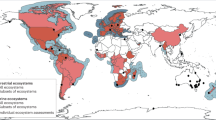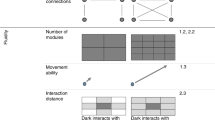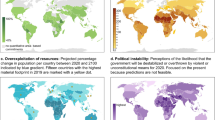Abstract
There is a pressing need to apply stability and resilience theory to environmental management to restore degraded ecosystems effectively and to mitigate the effects of impending environmental change. Lakes represent excellent model case studies in this respect and have been used widely to demonstrate theories of ecological stability and resilience that are needed to underpin preventative management approaches. However, we argue that this approach is not yet fully developed because the pursuit of empirical evidence to underpin such theoretically grounded management continues in the absence of an objective probability framework. This has blurred the lines between intuitive logic (based on the elementary principles of probability) and extensional logic (based on assumption and belief) in this field.
This is a preview of subscription content, access via your institution
Access options
Access Nature and 54 other Nature Portfolio journals
Get Nature+, our best-value online-access subscription
$29.99 / 30 days
cancel any time
Subscribe to this journal
Receive 12 digital issues and online access to articles
$119.00 per year
only $9.92 per issue
Buy this article
- Purchase on Springer Link
- Instant access to full article PDF
Prices may be subject to local taxes which are calculated during checkout

Loch Leven photograph (left image), Jim Hampson/Scottish Natural Heritage; Windermere photograph (middle image), Mitzi M. De Ville; Müggelsee photograph (right image), T. Hintze.


Calhoun Lake photograph (right image), Minneapolis Park and Recreation Board.

Similar content being viewed by others
References
Boettiger, C. & Hastings, A. Early warning signals and the prosecutor’s fallacy. Proc. R. Soc. B 279, 4734–4739 (2012).
Tversky, A. D. & Kahneman, D. Extensional versus intuitive reasoning: the conjunction fallacy in probability judgment. Psychol. Rev. 90, 293–315 (1983).
Carpenter, S. R. et al. Early warnings of regime shifts: a whole-ecosystem experiment. Science 332, 1079–1082 (2011).
Litzow, M. & Hunsicker, M. E. Early warning signals, nonlinearity, and signs of hysteresis in real ecosystems. Ecosphere 7, e01614 (2016).
Pace, M. et al. Reversal of a cyanobacterial bloom in response to early warnings. Proc. Natl Acad. Sci. USA 114, 352–357 (2017).
Wang, R. et al. Flickering gives early warning signals of a critical transition to a eutrophic lake. Nature 492, 419–422 (2012).
Grimm, V., Schmidt, E. & Wissel, C. On the application of stability concepts in ecology. Ecol. Model. 63, 143–161 (1992).
Anderson, T., Carstensen, J., Garcia, E. H. & Duarte, C. M. Ecological thresholds and regime shifts: approaches to identification. Trends Ecol. Evol. 24, 49–57 (2009).
Lees, K., Pitois, S., Scott, C., Frid, C. & Mackinson, S. Characterizing regime shifts in the marine environment. Fish Fish. 7, 104–127 (2006).
Folke, C. et al. Resilience thinking: integrating resilience, adaptability and transformability. Ecol. Soc. 15, 20–28 (2010).
Scheffer, M. et al. Anticipating critical transitions. Science 338, 344–348 (2012).
Dakos, V., Carpenter, S. R., van Nes, E. H. & Scheffer, M. Resilience indicators: prospects and limitations for early warnings of regime shifts. Phil. Trans. R. Soc. B 370, 20130263 (2015).
Drake, J. M. & Griffen, B. D. Early warning signals of extinction in deteriorating environments. Nature 467, 456–459 (2010).
Carpenter, S. R., Brock, W. A., Cole, J. J. & Pace, M. J. A new approach for rapid detection of nearby thresholds in ecosystem time series. Oikos 123, 290–297 (2014).
Veraart, A. J. et al. Recovery rates reflect distance to a tipping point in a living system. Nature 481, 357–360 (2012).
Dai, L., Vorselen, D., Korolev, K. S. & Gore, G. Generic indicators for loss of resilience before a tipping point leading to population collapse. Science 336, 1175–1177 (2012).
Burthe, S. J. et al. Do early warning indicators consistently predict nonlinear change in long‐term ecological data? J. Appl. Ecol. 53, 666–676 (2015).
Capon, S. J. et al. Regime shifts, thresholds and multiple stable states in freshwater ecosystems; a critical appraisal of the evidence. Sci. Total Environ. 534, 122–130 (2015).
Adrian, R. et al. Lakes as sentinels of climate change. Limnol. Oceanogr. 54, 2283–2297 (2009).
Gunderson, L. H. Ecological resilience—in theory and application. Annu. Rev. Ecol. Syst. 31, 425–439 (2000).
Scheffer, M., Carpenter, S., Foley, J. A., Folke, C. & Walker, B. Catastrophic shifts in ecosystems. Nature 413, 591–596 (2001).
Boerlijst, M. C., Oudman, T. & de Roos, A. M. Catastrophic collapse can occur without early warning: examples of silent catastrophes in structured ecological models. PLoS ONE 8, e62033 (2013).
Sommer, S., van Benthem, K. J., Fontaneto, D. & Ozgul, A. Are generic early-warning signals reliable indicators of population collapse in rotifers? Hydrobiologia 796, 111–120 (2017).
Kéfi, S., Dakos, V., Scheffer, M., Van Nes, E. H. & Rietkerk, M. Early warning signals also precede non-catastrophic transitions. Oikos 122, 641–648 (2013).
Boettiger, C. & Hastings, A. Tipping points: from patterns to predictions. Nature 493, 157–158 (2013).
Gsell, A. S. et al. Evaluating early-warning indicators of critical transitions in natural aquatic ecosystems. Proc. Natl Acad. Sci. USA 113, E8089–E8095 (2016).
Søndergaard, M., Larsen, S. E., Johansson, L. S., Lauridsen, T. L. & Jeppesen, E. Ecological classification of lakes: uncertainty and the influence of year-to-year variability. Ecol. Indic. 61, 248–257 (2016).
Connell, J. H. & Sousa, W. P. On the evidence needed to judge ecological stability or persistence. Am. Nat. 121, 789–824 (1983).
Sayer, C. D. et al. Long-term dynamics of submerged macrophytes and algae in a small and shallow, eutrophic lake: implications for the stability of macrophyte-dominance. Freshw. Biol. 55, 565–583 (2010).
Phillips, G., Willby, N. & Moss, B. Submerged macrophyte decline in shallow lakes: what have we learnt in the last forty years? Aquat. Bot. 135, 37–45 (2016).
Jeppesen, E., Søndergaard, M., Meerhoff, M., Lauridsen, T. L. & Jensen, J. P. Shallow lake restoration by nutrient loading reduction – some recent findings and challenges ahead. Hydrobiologia 584, 239–252 (2007).
Gutierrez, M. F. et al. Is recovery of large-bodied zooplankton after nutrient loading reduction hampered by climate warming? A long-term study of shallow hypertrophic Lake Søbygaard, Denmark. Water 8, 341 (2016).
Batt, R. D., Carpenter, S. R., Cole, J. J., Pace, M. L. & Johnson, R. A. Changes in ecosystem resilience detected in automated measures of ecosystem metabolism during a whole-lake manipulation. Proc. Natl Acad. Sci. USA 110, 17398–17403 (2013).
Brock, W. A. & Carpenter, S. R. Interacting regime shifts in ecosystems: implications for early warnings. Ecol. Monogr. 80, 353–367 (2010).
Francis, T. B. et al. Shifting regimes and changing interactions in the Lake Washington, U.S.A., plankton community from 1962–1994. PLoS ONE 9, e110363 (2014).
Kuiper, J. J. et al. Food-web stability signals critical transition in temperate shallow lakes. Nat. Commun. 6, 7727 (2015).
Stewart, R. I. A. et al. Mesocosm experiments in ecological climate change research. Adv. Ecol. Res. 48, 69–179 (2013).
Olsen, S. et al. Strong impact of nitrogen loading on submerged macrophytes and algae: a long-term mesocosm experiment in a shallow Chinese lake. Freshwater Biol. 60, 1525–1536 (2015).
Pace, M. L., Carpenter, S. R., Johnson, R. A. & Kurtzweil, J. T. Zooplankton provide early warnings of a regime shift in a whole lake manipulation. Limnol. Oceanogr. 58, 525–532 (2013).
Jeppesen, E. et al. Lake responses to reduced nutrient loading — an analysis of contemporary long-term data from 35 case studies. Freshw. Biol. 50, 1747–1771 (2005).
Lürling, M., Mackay, E. B., Reitzel, K. & Spears, B. M. Editorial — a critical perspective on geo-engineering for eutrophication management in lakes. Water Res. 97, 1–10 (2016).
Jeppesen, E. et al. Biomanipulation as a restoration tool to combat eutrophication: recent advances and future challenges. Adv. Ecol. Res. 47, 411–487 (2012).
Søndergaard, M. et al. Lake restoration in Denmark and The Netherlands: successes, failures and long-term effects. J. Appl. Ecol. 44, 1095–1105 (2007).
Huser, B., Brezonik, P. & Newman, R. Effects of alum treatment on water quality and sediment in the Minneapolis Chain of Lakes, Minnesota, USA. Lake Reserv. Manage. 27, 220–228 (2011).
Huser, B. J., Futter, M., Lee, J. T. & Perniel, M. In-lake measures for phosphorus control: the most feasible and cost-effective solution for long-term management of water quality in urban lakes. Water Res. 97, 142–152 (2016).
Tanentzap, A. J. et al. Cooling lakes while the world warms: effects of forest regrowth and increased dissolved organic matter on the thermal regime of a temperate, urban lake. Limnol. Oceanogr. 53, 404–410 (2008).
Fölster, J., Johnson, R. K., Futter, M. N. & Wilander, A. The Swedish monitoring of surface waters: 50 years of adaptive monitoring. Ambio 43, 3–18 (2014).
North, R. P., North, R. L., Livingstone, D. M., Köster, O. & Kipfer, R. Long‐term changes in hypoxia and soluble reactive phosphorus in the hypolimnion of a large temperate lake: consequences of a climate regime shift. Glob. Change Biol. 20, 811–823 (2014).
Sand‐Jensen, K., Bruun, H. H. & Baastrup‐Spohr, L. Decade‐long time delays in nutrient and plant species dynamics during eutrophication and re‐oligotrophication of Lake Fure 1900‐2015. J. Ecol. 105, 690–700 (2016).
Reid, P. C. et al. Global impacts of the 1980s regime shift. Glob. Change Biol. 22, 682–703 (2016).
May, L. & Spears, B. M. (eds) Loch Leven: 40 Years of Scientific Research. Understanding the Links Between Pollution, Climate Change and Ecological Response (Developments in Hydrobiology Vol. 218, Springer, Dordecht, 2012).
Scheffer, M. & Jeppesen, E. Regime shifts in shallow lakes. Ecosystems 10, 1–3 (2007).
Janse, J. H. et al. Critical phosphorus loading of different types of shallow lakes and the consequences for management estimated with the ecosystem model PCLake. Limnologica 38, 203–219 (2008).
Bayley, S. E., Creed, I. F., Sass, G. Z. & Wong, A. S. Frequent regime shifts in trophic states in shallow lakes on the Boreal Plain: alternative “unstable” states? Limnol. Oceanogr. 52, 2002–2012 (2007).
Monteith, D. T. et al. Dissolved organic carbon trends resulting from changes in atmospheric deposition chemistry. Nature 450, 537–540 (2007).
de Wit, H. A. et al. Current browning of surface waters will be further promoted by wetter climate. Environ. Sci. Technol. Lett. 3, 430–435 (2016).
Vuorenmaa, J. et al. Water quality of a small headwater lake reflects long-term variations in deposition, climate and in-lake processes. Boreal Environ. Res. 19, 47–66 (2014).
Couture, R. M., Wit, H. A., Tominaga, K., Kiuru, P. & Markelov, I. Oxygen dynamics in a boreal lake responds to long‐term changes in climate, ice phenology, and DOC inputs. J. Geophys. Res. Biogeosci. 120, 2441–2456 (2015).
Seekell, D. A., Carpenter, S. R., Cline, T. J. & Pace, M. J. Conditional heteroscedasticity forecasts regime shift in a whole-ecosystem experiment. Ecosystems 15, 741–747 (2012).
Seekell, D. A., Carpenter, S. R. & Pace, M. L. Conditional heteroscedasticity as a leading indicator of ecological regime shifts. Am. Nat. 178, 442–451 (2011).
Trolle, D. et al. Advancing projections of phytoplankton responses to climate change through ensemble modelling. Environ. Model. Softw. 61, 371–379 (2014).
Acknowledgements
B.M.S., E.J., L.C., S.J.T. and E.B.M. were supported in part by the MARS project (Managing Aquatic ecosystems and water Resources under multiple Stress) funded under the 7th EU Framework Programme, Theme 6 (environment including climate change), contract number 603378 (http://www.mars-project.eu/). B.M.S., L.M., L.C. and S.I. were supported in part by a grant from the Scottish government (RESAS) on ‘Predicting the impact of current and future drivers of change upon aquatic ecology’. S.I. was supported by a Natural Environment Research Council (NERC) PhD Studentship. R.A. acknowledges support by the EU Mantel project - a Marie Sklodowska-Curie Action; European Joint Doctorate Innovative Training Network (EJD, ITN). We thank all who have contributed to, and continue to support, the globally important long-term monitoring programmes of Loch Leven, Windermere, the Swedish Lakes (including Lake Härsvatten) and Müggelsee featured in this Perspective. We thank all with the foresight to collect and comprehensively assess the outcomes of the management activities at Calhoun Lake and Lake Engelshom. This Perspective was conceived during the workshop ‘Critical transitions in lakes’, December 2015, Edinburgh, UK, and supported by CEH and NERC through a National Capability programme on Ecosystem Processes & Resilience.
Author information
Authors and Affiliations
Contributions
All authors contributed to the original concept of this paper and to the development of the text. B.M.S., M.N.F., E.J., T.A.D., B.J.H. and S.J.T. led the preparation of the text and paper structure. S.I., B.J.H., E.J., M.N.F. and S.J.T. prepared the figures with data provided by E.B.M., H.W., S.I., L.M., B.J.H., R.A., M.S., M.N.F. and A.S.G. B.M.S. led the final draft preparation and submission stages with comments from all authors being received prior to submission.
Corresponding author
Ethics declarations
Competing interests
The authors declare no competing financial interests.
Additional information
Publisher’s note: Springer Nature remains neutral with regard to jurisdictional claims in published maps and institutional affiliations.
Rights and permissions
About this article
Cite this article
Spears, B.M., Futter, M.N., Jeppesen, E. et al. Ecological resilience in lakes and the conjunction fallacy. Nat Ecol Evol 1, 1616–1624 (2017). https://doi.org/10.1038/s41559-017-0333-1
Received:
Accepted:
Published:
Issue Date:
DOI: https://doi.org/10.1038/s41559-017-0333-1
This article is cited by
-
Diatom evidence of ecological change in a deep subtropical reservoir (southeastern China) over the past 60 years
Journal of Paleolimnology (2024)
-
Bimodality and alternative equilibria do not help explain long-term patterns in shallow lake chlorophyll-a
Nature Communications (2023)
-
Early warning signals have limited applicability to empirical lake data
Nature Communications (2023)
-
Nitrogen Reduction Causes Shifts in Winter and Spring Phytoplankton Composition and Resource Use Efficiency in a Large Subtropical Lake in China
Ecosystems (2023)
-
Bridging Theories for Ecosystem Stability Through Structural Sensitivity Analysis of Ecological Models in Equilibrium
Acta Biotheoretica (2022)



